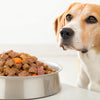Can Dogs Only Eat Wet Food? Exploring the Benefits and Considerations
- Houndsy
Table of Contents
- Introduction
- The Nutritional Considerations for Dogs
- Potential Benefits of Feeding Wet Food
- Considerations and Challenges
- Mixing Wet and Dry Food: A Balanced Approach
- Conclusion
Introduction
As pet owners, we all want the best for our furry family members. In fact, studies have shown that nearly 76% of dog owners consider their pets to be part of the family, and the decisions we make about their diets reflect this commitment. One prevalent question that often arises is: can dogs only eat wet food? This topic is particularly relevant as the market for wet dog food continues to grow, captivating the taste buds of our canine companions and gaining traction among conscientious pet owners.
In this blog post, we will dive deep into the world of wet dog food, examining its benefits and potential downsides, and addressing whether it can form a balanced diet for your dog. We will cover various aspects, from nutritional considerations to practical implications, empowering you to make informed decisions regarding your pet's feeding routine. By the end of this article, you will have a comprehensive understanding of wet dog food and whether it aligns with your furry friend’s needs.
So let’s embark on a journey to discover the ins-and-outs of dog nutrition and ponder some thoughtful questions about dog feeding routines: What are we currently feeding our dogs? Have we considered the variety of options available? Are we aware of the influences that our choices may have on their health?
The Nutritional Considerations for Dogs
When asking if dogs can thrive on a wet food-only diet, we must first consider their nutritional needs. Dogs, like humans, require a balanced diet that is rich in proteins, fats, carbohydrates, vitamins, and minerals. The two main types of commercially available dog food are dry (kibble) and wet (canned) foods, both of which can meet these needs if properly formulated.
The Composition of Wet Dog Food
For wet dog food, the primary ingredients typically include:
- Proteins: These are the foundation of a dog's diet, and should come from quality sources like meat, fish, or eggs.
- Fats: Essential for energy and cell function, healthy fats should comprise an appropriate portion of the diet.
- Carbohydrates: While dogs do not require a high carbohydrate intake, complex carbs can provide energy.
- Vitamins and Minerals: Critical for varied bodily functions, from immune system support to bone health.
Balancing Nutrition
A key consideration is ensuring that the wet food you choose is nutritionally complete. Many reputable brands formulate their wet food to meet the standards set by the AAFCO (Association of American Feed Control Officials), which evaluates the nutritional adequacy of pet foods. Just like with dry food, not all wet dog foods are created equal. Opting for high-quality brands ensures that your dog receives all necessary nutrients while avoiding fillers and artificial additives.
Potential Benefits of Feeding Wet Food
Wet dog food offers a variety of benefits, particularly for certain dogs and situations. Here are some compelling reasons to consider:
1. Enhanced Palatability
One of the most significant advantages of wet food is that it is often more flavorful and aromatic than dry kibble. This can be particularly beneficial for picky eaters, dogs recovering from illness, or senior dogs with diminished appetites. The moisture content and rich aromas can entice dogs to chow down eagerly, which is crucial for maintaining a healthy diet.
2. Increased Hydration
Wet dog food typically contains 75-80% moisture, making it a fantastic way to help keep your dog hydrated—especially important in warmer climates or for dogs that do not drink enough water on their own. Proper hydration is vital for a dog’s kidney health and overall well-being, particularly as they age.
3. Easier to Chew
The soft texture of wet dog food is easier for dogs to chew, which can be helpful for senior dogs or those with dental issues. While dry food is known to promote better dental health, it may not be suitable for all dogs, particularly those with existing oral problems.
4. Nutrient Density
Wet dog food often contains less filler and more real meat and nutrients, which can be desirable for maintaining a healthy weight. Moreover, wet food typically boasts higher protein content, making it suitable for dogs that require high protein, such as active breeds or those in the developmental stages of life.
5. Weight Management
Interestingly, wet dog food is sometimes used for weight management. The lower calorie density, combined with the increased water content, can lead to a feeling of fullness without overconsumption. When it comes to promoting healthy weight in dogs, wet food can be a helpful addition.
Considerations and Challenges
While wet food is an excellent choice for many dogs, important considerations should also be taken into account, including:
1. Cost Implications
Wet dog food can be more expensive than dry food. For larger dogs or multiple dog households, the expenses can quickly add up. Careful budgeting is crucial if you plan to feed your dog only wet food. Exploring bulk purchase options or value packs may offer cost-saving opportunities.
2. Inconvenience in Storage and Serving
Wet food can spoil rapidly, meaning any uneaten portions should be refrigerated and used within a few days. Additionally, it generally requires more effort to serve and clean up compared to kibble—another important factor to consider for busy pet owners.
3. Dental Health Concerns
As mentioned earlier, while wet food is easier to chew, it does not scrub the teeth in the way that dry food can. Dogs who consume only wet food might be at risk for tartar buildup and associated dental problems if proper dental care—such as regular check-ups and dental chews—is not maintained.
4. Gastrointestinal Sensitivities
For dogs with sensitive stomachs, dietary changes must be approached cautiously. The transition from dry to wet food should be gradual to avoid gastrointestinal disturbances. Moreover, certain dogs may react differently to specific ingredients, necessitating careful observation to ensure that wet food does not cause digestive issues.
Mixing Wet and Dry Food: A Balanced Approach
Given the potential benefits and drawbacks of both wet and dry food, many pet owners find success in mixing the two. This not only combines the advantages of each type of food but also allows for more customized feeding options based on a dog's unique preferences and nutritional needs.
A Balanced Meal
Combining wet and dry food can create a balanced meal that promotes hydration while providing the dental benefits of kibble. When doing so, it's essential to calculate the proportions carefully to ensure your dog receives appropriate daily caloric intake. Consulting with a veterinarian can offer insights into achieving optimal nutritional balance.
Encouraging Picky Eaters
Mixing wet food into dry kibble can entice picky eaters to consume their meals. The mix boosts flavor and aroma, eliminating the dullness that sometimes comes with feeding kibble alone.
Addressing Special Needs
For senior dogs, mixing moist food can soften the kibble and provide added hydration, catering to their specific dietary needs. Similarly, incorporating wet food can be a useful strategy during periods of illness or recovery when a dog’s appetite may be diminished.
Conclusion
In response to our initial question, can dogs only eat wet food?—the answer is yes, provided that the wet food is nutritionally complete and fits the individual needs of your furry friend. There are distinct advantages to choosing wet food, including increased palatability, hydration benefits, and ease of chewing. However, it is crucial to consider the financial implications, potential dental health concerns, and suitability based on your dog’s unique requirements.
Ultimately, the best feeding strategy may involve a combination of both wet and dry foods to accommodate your dog's preferences while ensuring they receive a well-rounded, nutritious diet.
As we consider our pets’ feeding habits, let’s ask ourselves: Are we providing the right balance? How are our choices affecting their health and happiness?
If you're curious about elevating your dog’s feeding experience with a stylish and functional solution, we invite you to explore the Houndsy Kibble Dispenser, designed to simplify and beautify the daily feeding ritual. Order Now!
FAQ
Q: Can dogs survive on wet food alone?
A: Yes, as long as the wet food is nutritionally balanced and tailored to their specific needs.
Q: Is wet food more fattening than dry food?
A: Wet food is not inherently more fattening; in fact, it often contains fewer carbohydrates, which can aid in weight management.
Q: Are there specific breeds that benefit more from wet food?
A: Senior dogs, puppies, or dogs with dental issues often benefit from wet food due to its softer texture and enhanced hydration.
Q: Does feeding wet food instead of dry food affect my dog's dental health?
A: Yes, wet food does not provide the same dental benefits as dry food, so regular dental care is essential even if you feed wet food.
Q: How can I transition my dog from dry food to wet food?
A: Transition gradually by mixing small amounts of wet food into their current diet and increasing the wet food proportion over several days.
Q: Can I mix wet and dry food?
A: Yes, combining the two can offer the benefits of both and may appeal to picky eaters. Just make sure to adjust portions accordingly to maintain balanced nutrition.












